
- India’s strategy of multilateral engagement has been imperative when it comes to the concept of “strategic autonomy” where India’s choices have been diversified to engage with multiple players.
- India’s paradigm shift from being a traditional non-aligned state to a state that has adopted ‘multi-alignment’ as part of its foreign policy has been witnessed in recent years.
- India has initiated and pioneered several multilateral forums like SAGAR whose objective is to cooperate on the sustainable use of Indian Ocean waters.
- India-led multilateral initiatives include the International Solar Alliance (ISA) whose primary objective is working for efficient consumption of solar energy.
India’s paradigm shift from being a traditional non-aligned state to a state that has adopted ‘multi-alignment’ as part of its foreign policy has been witnessed in recent years with the coming of the current dispensation. The multiple strands of India’s multilateral engagement are being manifested by India’s participation in various multilateral forums. India’s aspiration of leading the global south was further synchronized with the inclusion of the African Union in the G20 following the 2023 summit that was held in New Delhi.
The SCO, a multilateral forum that has its origins in the Russia-China axis following the Soviet disintegration for cooperation among the different post-Soviet Central Asian Republics to maintain regional stability and security has now been an essential strategic forum for India following India’s entry into the SCO in 2017 along with Pakistan. The SCO gives India the platform to engage with Central Asia, primarily from the connectivity perspective as Pakistan has been acting as a historic wall between India, Central Asia and Afghanistan. India launched its ‘Connect Central Asia Policy’ in 2012 which was further synchronized with the visit of PM Modi to all the five Central Asian countries, Kazakhstan, Kyrgyzstan, Uzbekistan, Tajikistan and Turkmenistan in 2015.
Iran, one of India’s cordial West Asian allies has also been granted membership of the SCO which is indeed a blessing for India as Iran is an important transit point for connecting it with Central Asia and Afghanistan. The International North-South Transport Corridor (INSTC) launched in 2000 has played its part well in this regard which also includes Indian-sponsored and India-developed Chabahar port that connects it with the Zaranj Delaram Highway, which is an important highway in Afghanistan that was developed by the Indian Border Roads Organization (BRO). However, changing geopolitical situations in the region like the Taliban takeover of Afghanistan affected the ongoing trade engagements in the region and sanctions on Iran by the US. Iran is also important for India when it comes to energy security as Iranian oil used to be one of the most imported products until 2019 before sanctions were imposed.
Under the current dispensation, India has initiated and pioneered several multilateral forums. This includes the SAGAR doctrine which stands for ‘Security and Growth for All in the Region’ whose objective is to cooperate on the sustainable use of Indian Ocean waters. It also has an objective to strengthen the economic and security ties with India’s maritime neighbours. Other such India-led initiatives include the International Solar Alliance (ISA) whose primary objective is to work towards efficient consumption of solar energy. It was a joint Indo-French-initiated project in 2015 that was launched as part of the India-Africa Summit.
India-US strategic convergence about China has led New Delhi to become a key player in the Indo-Pacific paradigm as part of the four-member QUAD along with Australia and Japan.
In June 2016, India became the 35th member of the Missile Technology Control Regime (MTCR) which is an informal and voluntary partnership among different countries to prevent proliferation of missile and unmanned aerial vehicle technology. India’s efficient diplomacy was again witnessed in 2017 when it joined the Wassenaar Arrangement as its 42nd member. The Wassenaar Arrangement is a grouping of an elite club of countries that are part of the nuclear multilateral export control regime.
India’s multi-alignment strategy is further reckoned with by the rise of an assertive China with whom the US is currently at loggerheads on several issues starting from the trade war to the Taiwan issue. India-US mutual strategic convergence about China has led New Delhi to become a key player in the Indo-Pacific paradigm as part of the four-member QUAD or Quadrilateral Security Dialogue along with Australia and Japan. It has further led to India’s ‘ Act East Policy’ being integrated into the greater multilateral Indo-Pacific strategy to secure and stabilize the crossroads connecting the Indian Ocean periphery to the East Asian Pacific periphery, of which the South East Asian region is an important and strategic part. India has also become an important component of the recently initiated I2U2 forum. I2U2 stands for Israel, India, US & UAE whose roots can be traced back to the 2020 Abraham Accords between UAE and Israel which normalized their diplomatic relations after years of diplomatic isolation.
Therefore, it can be concluded that India’s policy of engaging with members who are strategically viable and important is driven by its national interests. India’s strategy of multilateral engagement has been imperative when it comes to the concept of “strategic autonomy” where India’s choices have been diversified to engage with multiple players.
(The author has a PG in International Relations from Jamia Millia Islamia Central University and is a freelance writer. Opinions expressed are the author’s own)
Riddhik Parashar is a researcher specialising in South Asian security dynamics, border conflicts, and strategic affairs. His expertise lies in analysing insurgencies, counter-terrorism policies, and geopolitical shifts in India’s neighborhood. Views expressed are personal.
